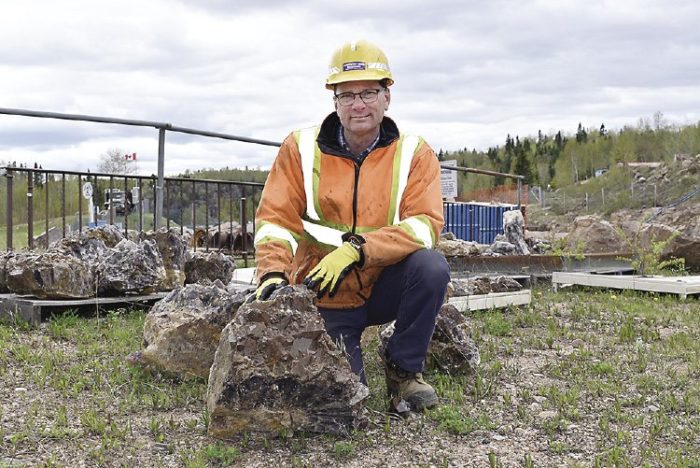In the increasingly popular world of healing crystals, amethyst is one of many semi-precious stones that is attracting attention from the alternative medicine resurgence. People who are part of the crystal trend are heading to Thunder Bay, where there is an abundance of the purple-hued stone, the province’s official gemstone. But whatever draws people to amethyst, be it powerful energies or Top-10-Things-to-Do tourism, it’s worth stopping to take a look at the royally coloured rocks. Much more than a souvenir to the geologists who take a closer look at amethyst, its visible pieces of granite and layers of bleached stone are a conduit to a billion-year-old story—the story of the birth and evolution of a purple rock.
Because geologists study existing amethyst and try to map its story backwards, there remains some degree of mystery and dispute about its formation. There is no universal agreement on how amethyst deposits form, however, Dr. Stephen Kissin, professor emeritus of the Lakehead University Geology Department, says that in general, there are a few specific conditions that must be present for the purple rock to form: iron, the correct temperature range, and ionizing radiation. Different theories, however, have their own take on the particular conditions that create amethyst.
A simple definition of amethyst describes the rock as a quartz crystal that gets a dose of iron as it forms. But while iron is necessary, it’s not hard to find, nor is a lot of it needed. The amount of iron is often overstated. “We’re only talking iron in the range of 10 to maybe 100 parts-per-million, so a very low amount of iron,” Dr. Kissin explains.
The temperature at which amethyst forms is one of the most debated conditions. In a 1995 paper on the genesis of amethyst at the Thunder Bay Amethyst Mine, Kissin and his colleagues argued that the purple rock formed at a fairly low temperature—no higher than 115 degrees Celsius (239 degrees F).
Additionally, some theories suggest that the formation of amethyst requires the presence of aluminum. But even if this were necessary, aluminum is, like iron, a very common element on Earth. In fact, none of the basic conditions that are essential for the formation of the purple rocks are particularly special. As Kissin states, the conditions for amethyst are “not very hard requirements to meet.” These purple rocks, it turns out, were just in the right place at the right time.
The Thunder Bay Amethyst Mine, the largest in North America, was discovered incidentally during the construction of a forest-access road to bring in building supplies for the construction of a fire tower. The mine has been in operation since the 1960s, when sales of amethyst landscape and fireplace stones across Canada and the U.S. began, and a “dig-your-own” amethyst feature for tourists was developed. The mine was purchased by Steve Lukinuk in 1981 and has since been renamed Amethyst Mine Panorama. Lukinuk’s son, Tim, works at the mine full-time and says that mining amethyst never fails to provide a sense of discovery for him. “We find [our] visitors have the same feeling… just finding something, it’s just kind of magical.”

Lukinuk compares the experience of finding amethyst at the mine to the allure that beachcombing provides for people of all ages. Except instead of a lapping ocean, there’s a lush landscape of boreal forest, and instead of seashells, there are rocks. But the thrill of finding that perfect piece of purple crystal, and then another one, may be where amethyst offers its highest value. After the discovery of large deposits in Brazil, amethyst’s status was reduced to a semi-precious stone, and its abundance allows Amethyst Mine Panorama to sell the unpolished stone for $4 per pound. Lukinuk notes that the problem for anyone who visits the amethyst mine to dig for the rocks is “not ‘will I find any’, but ‘will I find too much.’”
Back in the mine’s gift shop, employees Falon and Mavis muse about the value of amethyst. Falon talks about the nostalgia of being fascinated as a kid by the purple stone displayed in her grandparent’s home—“It was the coolest rock,” she smiles. And Mavis talks about how working at the mine has led her to appreciate amethyst: “When you are born and raised here, it’s just another rock. But then you come up here and you realize it’s a semi-precious stone and look at all the work that goes into making it this way.”
With a less than lucrative status in the ranking of gemstones, amethyst may be better served instead by those who find their own way to appreciate amethyst for what it is. After all, it may very well just be Earth dust and ions, brought into our tangible grasp, and empowering us to figure out its mysteries.—Geena Mortfield




